FDA Considers COVID-19 Boosters for J&J and Mix/Match Boosters
Tagged:COVID
/
Math
/
MathInTheNews
/
PharmaAndBiotech
/
SomebodyAskedMe
/
Statistics
Today the FDA’s Vaccines and Related Biological Products Advisory Committee meets to review the Johnson & Johnson/Janssen application for 2nd dose boosters of their COVID-19 vaccine. They will also at least discuss the 3x3 mix-and-match booster study.
Kind of not as interested?
To be honest, the J&J vaccine just doesn’t interest me as much. I wish well to all those who got it, but it’s just a bit outside my sphere of experience. So I won’t be blogging this hearing in as much detail as for Pfizer and Moderna.
That being said, I’ll happily assemble here a bibliography of the meeting materials for anyone who does care to dig in, and will gratefully read any summary they might write:
- Helen Branswell & Matt Herper at STAT News are doing their usual live-blogging, so that’s always a good place to look for callouts of the main points. [1]
- The FDA’s meeting announcement page [2], same as for yesterday, now has new materials for J&J uploaded. The rest of the meeting materials are available there.
- The official agenda [3] calls for a decision on the J&J booster, then discussion of the mix-and-match trial.
- The YouTube livestream of the hearings is also available, embedded here for the truly compulsive. (Did I really just say that?)
A Glimpse of J&J Efficacy Persistence
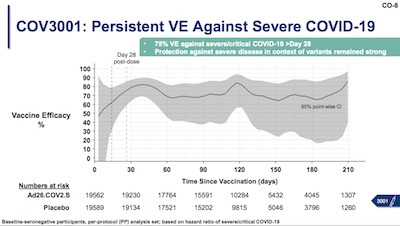
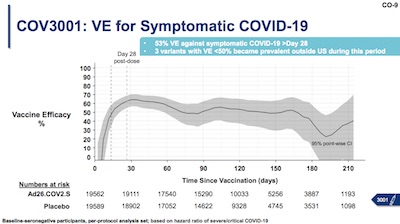
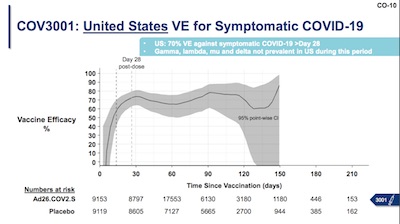 The one extract I will highlight from a quick trawl through the
slides [4] is this one: it
appears J&J efficacy has not waned as much as others. Nobody really has much of any
idea why this is the case, or even how much to trust the data that says so.
The one extract I will highlight from a quick trawl through the
slides [4] is this one: it
appears J&J efficacy has not waned as much as others. Nobody really has much of any
idea why this is the case, or even how much to trust the data that says so.
The situation is less copacetic when you consider just symptomatic COVID-19 efficacy. It peaks at about 65% one month after vaccination, and then declines to about 30%, with the 95% confidence interval not bounded away from 0, i.e., there’s some chance it has vanished.
If for some reason you’re interested in the US-only data, it’s slightly better: moderate efficacy, reasonably persistent over time. (Though, as you can see at the end, the confidence interval widens out. That’s probably just because there are fewer and fewer people who have had the vaccine long enough, not that it’s fading.) I have no idea why this should be better than the previous international data.
In one sense, this is good news: J&J endures. In another sense, it weakens the case for boosters, unless boosters are to get to even higher levels of immunity, comparable to the mRNA vaccines, or to repair the efficacy against non-severe COVID-19. People are starting to say this should be a 2-shot vaccine from the start, maybe with the second dose at 6 months. Which is kinda now.
There does seem to be less clotting risk with the 2nd dose of J&J compared to the first, so that at least is good.
The Discussion Period
According to Helen Branswell, the discussion was not to J&J’s liking. They want to remain a 1-dose vaccine because that appeals to some people, and they don’t want heterologous boosters with somebody else’s vaccines. However, the VRBPAC members think otherwise:
1:25 p.m.: This is turning out to be a bad meeting for J&J. It’s clearly the view of a lot of VRBPAC members that this vaccine should be a two-dose vaccine. And it’s also apparent that the FDA is thinking about whether the boost for the J&J vaccine should be another brand of vaccine.
The Vote
At 1:30pm, the vote came down unanimously in favor of allowing boosters: 19 Yes, 0 No, 0 Abstain. The question implied “at least 2 months” after the first dose, but didn’t exactly specify when.
The Mix-and-Match Clinical Trial
The VRBPAC won’t actually vote on this, but they will discuss it, making “general observations” to the FDA on the heterologous vaccine study. [5] “Heterologous” is just terminological inflation; heterologous and homologous just mean “same” and “different” as they’re used here.
Obviously, this was a government-run trial at the NIH/NIAID, since we can never expect private companies to do trials with their competitors’ vaccines! In fact, during the J&J presentation, according to Helen Branswell, J Van Hoof of J&J appeared to try to block consideration of heterologous boosts, asserting without proof that their safety had not been proven as much as J&J boosted with J&J had been. Was he unaware of the safety study being presented this very afternoon?!
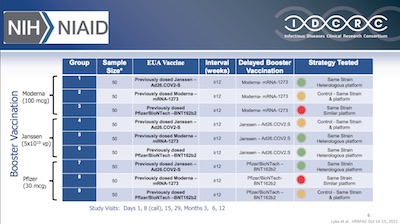 This study used all 3 vaccines in combination with each other, in both orders in a 2-dose
scheme. Imagine the 3x3 grid that makes, and you get 9 combinations including the
controls where you used the same vaccine twice. It looks like they
did one dose of the first vaccine, then 12 weeks later did the second dose and called that
the “booster”. Seems rational enough to me. Each of the 9 arms (!) had 50 participants,
so it’s kind of small, but good for exploratory purposes.
This study used all 3 vaccines in combination with each other, in both orders in a 2-dose
scheme. Imagine the 3x3 grid that makes, and you get 9 combinations including the
controls where you used the same vaccine twice. It looks like they
did one dose of the first vaccine, then 12 weeks later did the second dose and called that
the “booster”. Seems rational enough to me. Each of the 9 arms (!) had 50 participants,
so it’s kind of small, but good for exploratory purposes.
For immunogenicity, they measured both pseudovirus neutralization (D614G, with Beta and Delta still in process) and IgG antibody binding. So they didn’t just measure blood antibody levels in subjects, which is very good indeed.
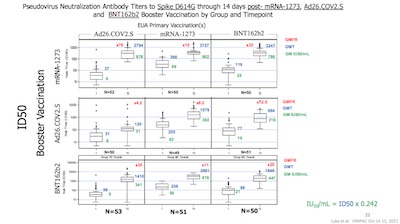
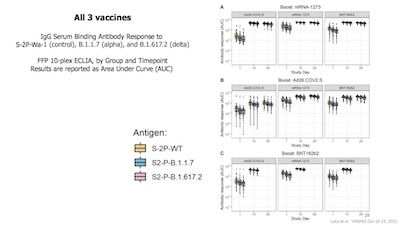 The result seems to be, approximately: hey, it worked.
The result seems to be, approximately: hey, it worked.
The first slide here shows the result for pseudovirus neutralization: bigger is better, and the vertical axis is on a log scale. This is for the D614G variant. It looks like the mRNA vaccines all do comparably well with whatever booster happens; the J&J does better with an mRNA boost than with itself. It also looks like the heterologous boosts were as good or higher than the homologous ones, which strong encourages mixing boosters!
The second slide shown here shows the result for IgG antiobody binding on all 9 vax combinations, this time using 3 variants of concern: WT, Alpha, and Delta. They all get better with boosts and time, but J&J boosting itself was the weakest of the lot.
They also reported safety outcomes, basically saying nothing special happened.
So it looks to me like the conclusion should be:
- heterologous vaccines work, possibly better than homologous (so we should do them), and
- the J&J vaccine boosting itself is the weakest kitten in the basket (it’s probably ok, just not as good as the others).
Too bad the VRBPAC won’t be allowed to vote/recommend on this topic, as the data is somewhat early! But maybe in the near future.
Ok, that all seems reasonably clear. I listened to some of the discussion, and people pretty much agreed.
The issues that concerned them were something like the CDC’s ACIP can’t make a recommendation unless the FDA gives an approval or at least an EUA, so the next step for the FDA is to let these data mature and then consider a mix-and-match EUA. There was some chit-chat about what data people would like to see to make that happen. (Kurilla disagreed that an EUA would be required, given that all 3 vaccines are at least EUA’d or even fully approved. They could move as soon as Moderna and J&J are fully approved. So that’s a potential shortcut, maybe?)
There was even some discussion of lowering the age at which people can ask for a booster without complicating conditions from 65 to 40! At that point… come on, just give everybody a booster, I say.
The Weekend Conclusion
Looks like I got 3 things, 2 of which are nontrivial:
- J&J boosters approved, sort of:
- On the one hand, J&J boosters were recommended to the FDA by unanimous vote of the entire VRBPAC.
- On the other hand, sentiment seems to be that this should have been a 2-dose vaccine from the start, and heterologous boosters with another vaccine might be better.
So from the J&J viewpoint, they might see this as 1 win and 2 losses.
- The mix-and-match study gave fabulous results:
- safety was pretty high, and
- the heterologous efficacies were as good or better than homologous.
The next step will be to mature this study a bit, with a few more assays to measure activated T-cell or memory B-cell response, add a few more groups, and then move for an EUA. At that point, the CDC’s ACIP could issue a recommendation for practice. Or, as Kurilla pointed out, full approval for Moderna and J&J might grease the skids there, allowing a bit less deliberation.
- One side-effect of watching some of the mix-and-match discussion was that I could observe the chair, Arnold Monto, as he was talking to the speakers and moderating the discussants. He tends to smile at them, as if he’s having a good time — sort of warms my cold, skeptical heart a bit. I kind of like the guy. (I did not like the way they all religiously called each other “doctor”; that never happens in, for example physics, where it would just sound pompous. Cultural differences…)
J&J may consider this a mixed result, but I think for the general welfare this was a good day.
Addendum 2021-Oct-20: FDA Authorizes Moderna, J&J Booster, and Mix&Match Boosters
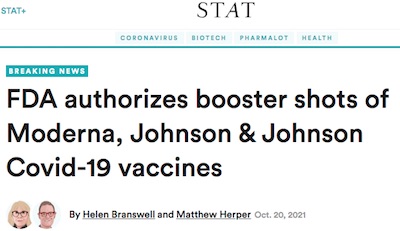
 Today the FDA acted on the VRPBAC recommendation, and actually went futher. Not only did
they grant EUA for both the Moderna and J&J boosters, they also granted EUA for
mix&match boosters, despite the preliminary nature of the presented evidence at
VRBPAC. This news comes via STAT News [6], reporting on
the actual FDA statement issued today. [7]
Today the FDA acted on the VRPBAC recommendation, and actually went futher. Not only did
they grant EUA for both the Moderna and J&J boosters, they also granted EUA for
mix&match boosters, despite the preliminary nature of the presented evidence at
VRBPAC. This news comes via STAT News [6], reporting on
the actual FDA statement issued today. [7]
This is a very aggressive move for them, indicating that they really want people to get boosted.
The steps remaining are that the CDC’s ACIP meeting has to recommend this as standard medical policy, and CDC Director Rochelle Walensky has to sign off on the recommendation. The ACIP meets tomorrow, 2021-Oct-21.
Authorization would significantly simplify boosting long-term care facility residents, for example. Vax teams would only have to bring one type of vaccine for everybody, instead of all 3 to handle any variation in initial doses among the residents.
Right now, the eligible populations are:
- Anybody who previously got J&J.
- Anybody who previously got Moderna or Pfizer, and:
- Are over age 65, or
- Are aged 18-64 and have pre-existing conditions placing them at severe risk of COVID-19, or
- Are aged 18-64 and have jobs or living circumstances that put them at higher exposure to COVID-19.
With only a quick look at the numbers, that’s at least half the US population, outside kids. Branswell & Herper’s article suggests this includes 60% of people aged 18-64 + all 65 or older, so maybe a bit more than half! The rest, I’m sure, can come up with a sufficiently creative argument to persuade a tech at their local pharmacy. Practically, this is just about everybody in the US except kids?
Let’s hope that the CDC and ACIP turn this “permissive” language into “preferential”, as Branswell & Herper put it.
Addendum 2021-Oct-21: CDC’s ACIP & Director Recommend Moderna, J&J Booster, and Mix&Match Boosters
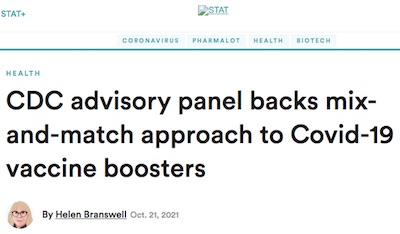 Today the CDC’s Advisory Committee on Immunization Practice (ACIP) met to consider
practice recommendations around Moderna boosters, J&J boosters, and mix-n-match
boosters. As always, Helen Branswell at STAT News has the
goods. [8] If you want to read through the 7 hours of
presentations that rehash the data from the FDA VRBPAC meeting, they’re now online
too. [9]
Today the CDC’s Advisory Committee on Immunization Practice (ACIP) met to consider
practice recommendations around Moderna boosters, J&J boosters, and mix-n-match
boosters. As always, Helen Branswell at STAT News has the
goods. [8] If you want to read through the 7 hours of
presentations that rehash the data from the FDA VRBPAC meeting, they’re now online
too. [9]
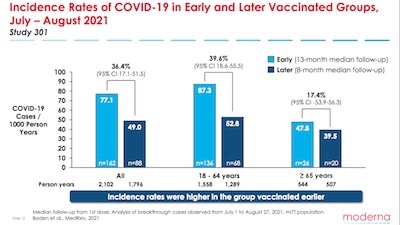 I looked briefly through all the slide decks. There’s a lot of stuff there, but it’s
mostly stuff we’ve seen before, just tweaked for the audience. One slide I’d like to call
out is slide 12 of the presentation for Moderna boosters.
I looked briefly through all the slide decks. There’s a lot of stuff there, but it’s
mostly stuff we’ve seen before, just tweaked for the audience. One slide I’d like to call
out is slide 12 of the presentation for Moderna boosters.
- It shows rates of COVID-19 cases (in units of cases/1000 person-years on the vertical axis).
- The 3 groups break down subjects into all, young, and old categories.
- The real info is in the difference between the light blue (early vaccinees) and dark blue (late vaccinees). I think the light blue bars are the people who were controls in the clinical trial; when the trial ended they got the real Moderna doses. So they’re pretty much the same, just vaccinated some 5 or 6 months later.
- They offer as evidence of vaccine efficacy waning that the light blue bars are all higher, i.e., the early vaccinees got “breakthrough” COVID-19 at a higher rate than the later vaccinees. (Though both are astronomically lower than unvaccinated people.)
- On the other hand: this seems to be convolved with the appearance of Delta, so I’m not absolutely certain this definitely means VE waning. Still… another chip on the pile, and it’s adding up.
Bottom line: The CDC’s ACIP basically agreed with the FDA’s VRBPAC, and recommended to the CDC that practice guidance include boosters for all 3 vaccines, and that mix-n-match was probably a good thing. There was, of course, some talk of guiding people one way or another: young men discouraged from a 3rd mRNA dose because of myocarditis risk, or young women discouraged from a 2nd J&J risk because of thrombosis. In the end, there was no formal guidance on that, though every doctor in the developed world knows those things anyway and will probably give that advice to their patients.
Those who are immunocompromised can get a full-dose 3rd shot of Moderna, while those who are immunologically normal get the “booster” dose, which is half the initial dose.
The next step would be to see of CDC Director Rochelle Walensky makes it official, resulting in clinical guidance. However, she took that step late this evening. So we’re done here: boosters are on, for those over 65 or 18-65 with risky conditions or risky jobs or living environments.
“These recommendations are another example of our fundamental commitment to protect as many people as possible from Covid-19,” Walensky said in a statement, noting the country now has three authorized booster doses that “are all highly effective in reducing the risk of severe disease, hospitalization, and death even in the midst of the widely circulating Delta variant.”
That’s probably 60% or more of the US population, with nearly every age 18+ person able to find some excuse or other. For example, being overweight but not obese (25 < BMI ≤ 30) is on the list of medical conditions increasing COVID-19 risk. And we Americans tend to be pretty fat.
Notes & References
1: H Branswell & M Herper, “Tracking the FDA advisory panel meeting on the J&J Covid vaccine booster”, STAT News, 2021-Oct-14. ↩
2: FDA Staff, “Vaccines and Related Biological Products Advisory Committee October 14-15, 2021 Meeting Announcement”, FDA VRBPAC 2021-Oct-15 Materials, retrieved 2021-Oct-15. ↩
3: FDA Staff, “170th Meeting of the Vaccines and Related Biological Products Advisory Committee October 14-15, 2021 DRAFT AGENDA”, FDA VRBPAC 2021-Oct-15 Materials, retrieved 2021-Oct-15. ↩
4: P Heaton, J Van Hoof, S Schneeweiss, D Barouch, & M Douoghuih, “Emergency Use Authorization (EUA) Amendment for a Booster Dose for the Janssen COVID-19 Vaccine (Ad26.COV2.S)”, FDA VRBPAC 2021-Oct-15 Materials, retrieved 2021-Oct-15. ↩
5: K Lyke, et al., “DMID 21-0012 - Heterologous Platform Boost Study Mix and Match”, FDA VRBPAC 2021-Oct-15 Materials, retrieved 2021-Oct-15. ↩
6: H Branswell & M Herper, “FDA authorizes booster shots of Moderna, Johnson & Johnson Covid-19 vaccines”, STAT News, 2021-Oct-20. ↩
7: FDA Office of Media Affairs, “Coronavirus (COVID-19) Update: FDA Takes Additional Actions on the Use of a Booster Dose for COVID-19 Vaccines”, FDA press announcements, 2021-Oct-20. ↩
8: H Branswell, “CDC advisory panel backs mix-and-match approach to Covid-19 vaccine boosters”, STAT News, 2021-Oct-21. ↩
9: CDC Staff, “ACIP Presentation Slides: October 20-21, 2021 Meeting (COVID-19 subset on 2021-Oct-21)”, _CDC ACIP Home, meeting materials, 2021-Oct-21. ↩

Gestae Commentaria
Comments for this post are closed pending repair of the comment system, but the Email/Twitter/Mastodon icons at page-top always work.